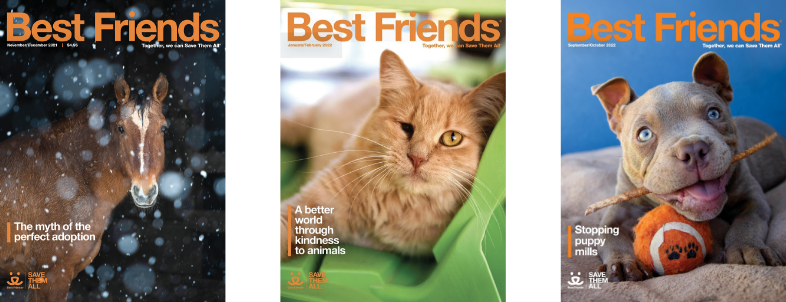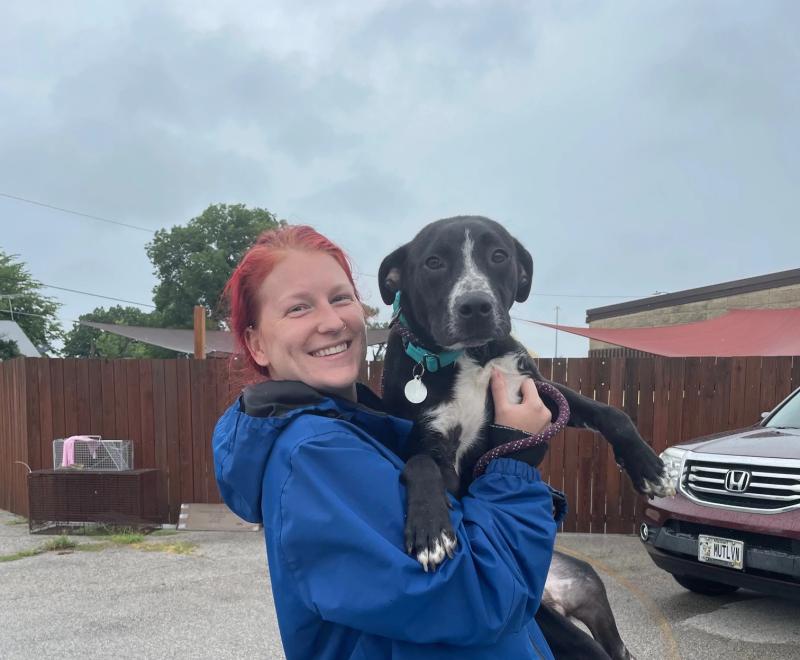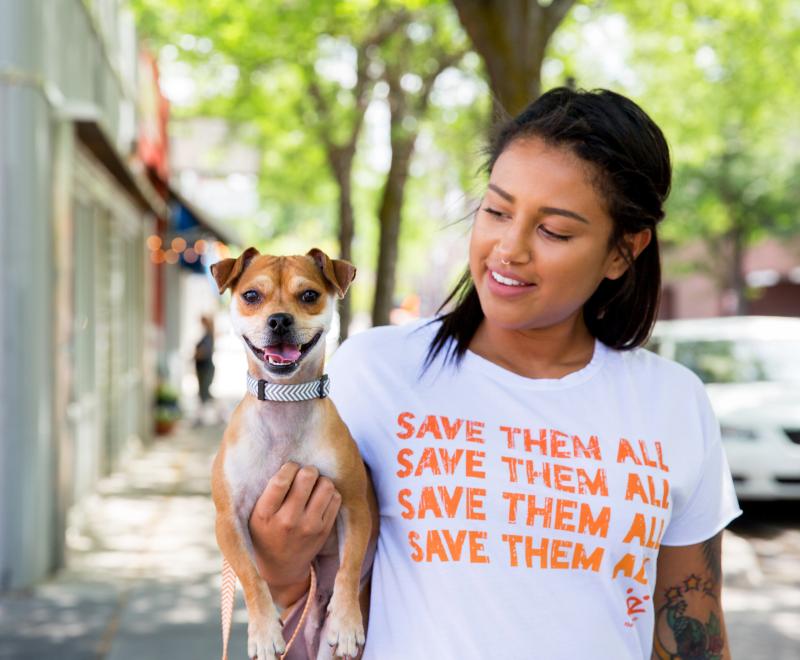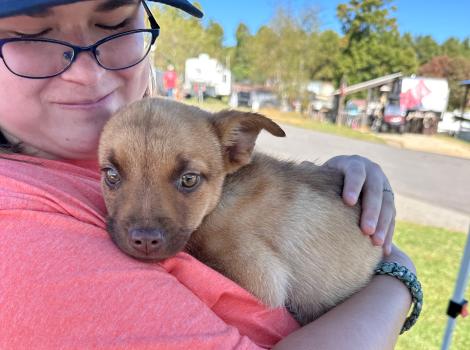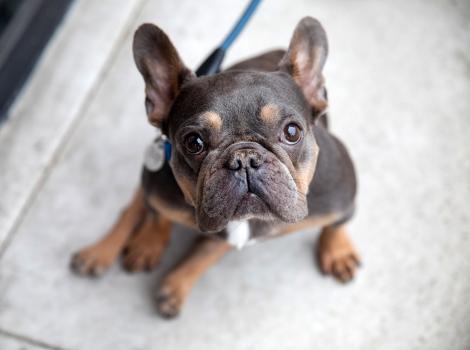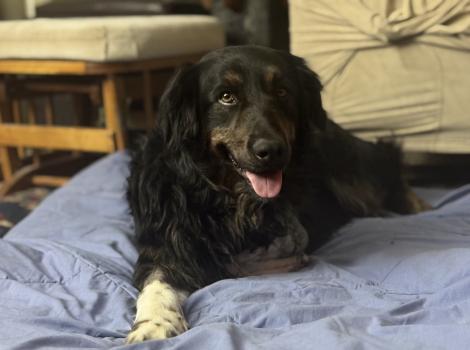The making of an animal shelter super mentor

It started with a piece of pizza and a kitten named Earl. In 2013, Savannah Rigley McDonald was working for a housing nonprofit called Rebuilding Together Southwest Illinois. One afternoon, while working on a wheelchair-accessible ramp for a house, she noticed a gray kitten darting around the job site.
“I love cats but knew absolutely nothing about community cats and kittens,” says Savannah. “I just assumed someone had dumped him there. But in retrospect, he was probably around 7 weeks old, born outside, and just orphaned. So there I am, running around this job site, trying to catch this kitten with a slice of pepperoni pizza!”
After failing to catch the kitten, Savannah reached out to a friend who worked with community cats. “I call this cat friend of mine,” says Savannah. “She tells me she can lend me a trap and tells me all about TNR (trap-neuter-return). Long story short, I spent two hours chasing that kitten, hoping he would come to me, and it took me 10 minutes to catch him with the trap.” A friend of a friend adopted the kitten and named him Earl. After that, Savannah was smitten with the world of expertise that went into saving Earl and other animals like him.

New super mentorship blossoms
Today, Savannah is co-executive director for Belleville Area Humane Society (BAHS) in southwest Illinois, and she’s bringing her kitten-loving and community-focused fire to the Best Friends Prince and Paws Shelter Collaborative Program, named after the beloved adopted pets of its lead investor and visionary partner. Through this program, Best Friends facilitates collaboration between no-kill shelters (mentors) and shelters that aren’t no-kill yet (fellows), with the former helping the latter to achieve and sustain no-kill. Best Friends supports each match with funding, training, and any other resources that might be needed.
In many cases, Best Friends plays matchmaker between mentor shelters looking to take on more of a leadership role and fellows in need of support in their lifesaving efforts. In the case of BAHS, Savannah and her team are participating in the program as a “super mentor” for several organizations with which they already had established relationships. BAHS wanted to strengthen those relationships further through the program.
Super mentors have the capacity to support more than one fellow at a time, and super mentorships allow organizations already working at the state or regional level to step into an influential leadership role. BAHS has achieved and sustained a save rate of 96% for the past two years while continuing to increase the number of animals they transfer into the shelter and the number of surrounding shelters and agencies they help.
[Communication, collaboration and cooperation]
“BAHS is a model for scaling local lifesaving,” notes Bethany Heins, director of the shelter collaborative program for Best Friends. “They’re maintaining their no-kill status while continuing to increase the number of animals they pull from the shelter fellows they’re partnered with.”
A 65-year-old private (100% donor-funded) shelter situated just east of the Missouri-Illinois border, BAHS has become a critical lifesaving connection between the resource-rich region of St. Louis, Missouri, and the more rural areas of southwestern Illinois. “We have this vibrant, bustling community of animal welfare players like CARE STL and Gateway Pet Guardians in metro St. Louis,” explains Savannah. “Then you move outward to southern Illinois, and it’s much less dense. There’s us and then a lot of these very rural animal control agencies.”
One such agency is Bond County Animal Control, located about 50 miles northeast of Belleville. Jim Hess, a devoted animal services officer for Bond County, considers BAHS to be a critical lifeline for his community. Recently, on his day off from work, he drove the 50 miles there to drop off an at-risk cat and her five kittens. “Because of this (shelter collaborative) program, I’m able to bring them here,” explains Jim. The mama cat, now named Sweetie Pie, is currently in a foster home with her kittens and will be adopted quickly thanks to BAHS’ robust adoptions program.

Support for rural areas
Earlier this spring, BAHS had already established formal shelter collaboration partnerships with the Humane Society of Southern Illinois, Bond County Animal Control, Madison County Animal Control, and Saline County Animal Control, and three additional contracts were underway with other animal services agencies they were already working with. “Savannah discovered how isolated her fellows all are,” notes Bethany. “They live in these geographic silos that isolate them not just from services but from colleagues who can serve as resources, too.”
One key attribute of any organization serving as a super mentor is its commitment to providing authentic support to fellows rather than forcing or dictating change. “We’re working with rural animal control agencies that certainly have the same desire to help animals in their communities that we do, but they lack the same resources and often have additional bureaucratic challenges that we don’t,” explains Savannah. “What I want fellow shelters to know is that we’re all about the journey and that we’re non-judgmental.”
One essential piece of the supportive role that BAHS plays in the region has been the remarkable and tireless team working alongside Savannah. “There’s often this expectation that everything with this work should be neat and clean, and there should be a perfect place for every pet just like the ones in our own homes,” says Savannah. “But in reality, there are just not enough resources for every animal in this country right now. Our staff get this, and that comes across to our partners.”
While conducting a site visit to Saline County Animal Control in the spring, Kaitlin Consolino, BAHS shelter mentor specialist, agreed to take three puppies who had arrived that day back with her to BAHS. During the puppies’ intake exam, it was discovered that all three had parvovirus, a highly contagious infection that can be fatal to dogs. The puppies were moved to a medical-focused foster home where they could safely complete treatment for the disease. All three have since recovered and have been adopted.
Savannah credits the quality of their ongoing partnership with Saline County Animal Control in large part to Kaitlin’s visit that day. “Because Kaitlin was there that day when those puppies came in, we unknowingly contained and prevented a devastating parvo outbreak at Saline,” she says. “This gave us the opportunity to talk with that team about how we properly contain infectious diseases at our own shelter and how we can work together in the future to prevent outbreaks on their end and ours. As a result, they’re now fully on board with the mentorship program and continuing to work with us. That’s a huge win.”

Doing a lot with a little
One of the more noteworthy aspects of BAHS as an organization is its ability to shine as a lifesaving leader with very few material resources of its own. When Best Friends’ shelter collaborative team members visited BAHS’ brick-and-mortar location earlier this year, they were stunned at the level of lifesaving the shelter was achieving despite its bare-bones facility. “How they managed their space and what they were doing with it was amazing,” emphasizes David Owens, senior strategist for the shelter collaborative program.
“Yes, I would say our little collection of buildings is woefully inadequate, and yet we make it work,” Savannah says with a laugh. “We were sitting with the Best Friends team at our conference table, and by ‘conference table’ I mean our lunch table, which is next to our surgery suite, and by ‘surgery suite’ I mean our kitchen counter.” Savannah is endlessly proud of how they make their small, outdated space work for them, and she absolutely should be. “Mentor shelters don’t have to be big and fancy. They don’t have to be rich, they don’t have to be sexy,” says Bethany. “The team at BAHS is doing so much with so little.”
[Tennessee animal shelter’s rapid turnaround]
What BAHS lacks in physical resources, they make up for with the human kind. For most of its 65-year existence, BAHS did not have an in-house veterinarian. This fact alone helps the staff connect and build trust with many of the fellow shelters they’re now mentoring who lack that same resource. In 2022, BAHS hired its first director of veterinary medicine. “Dr. Marquardt already had shelter medicine experience, which takes a special mindset,” Savannah notes. “She was well-versed in using donated supplies, working in cramped quarters and doing a whole lot for animals with very little.”
Switching to conversation-based pet adoptions (rather than a lengthy and restrictive adoption application) has been another cornerstone of BAHS’ “doing a lot with a little” prowess. After transitioning to a more welcoming adoption approach in late 2019, the shelter quickly doubled and eventually tripled the number of pets heading out the door to loving new homes. In 2019, 511 dogs and cats were adopted from BAHS. In 2023, that number skyrocketed to 1,726.
Savannah says, “We have two really professional adoption counselors, David and Melissa, who are straight-up dog and cat nerds. Our approach is ‘Come on in and let’s talk today so you and your pet can be together at home tonight.’ That’s the goal.”

An ode to lifesaving partnerships
While most of Best Friends’ super mentors focus on shelters in the South and the West Coast, the BAHS mentorship is a reminder that lifesaving happens everywhere. Originally from Southern California, Savannah is in awe of the beautiful community of people she works with every day at BAHS and in the greater animal welfare community. After recently saying goodbye to her senior dog, Betty Boop (who came from a rural shelter in Missouri), Savannah found herself surrounded by the passion and support that define the lifesaving partnerships she helps facilitate.
“These people are funny, compassionate, and hilariously dark sometimes. They remind me of what it means to be alive,” she says. “My TNR friend planted an apricot tree in my backyard for me after my dog passed last month. It’s so special to be known by other people. I feel like I know people here and I am known. We do that really well in the Midwest.”
The scrappy team at BAHS jumped on board with the Prince and Paws Shelter Collaborative Program because they knew it would position them to help even more pets and people in their corner of the country. And their fellow lifesaving organizations, including Best Friends, are very grateful to be known by and know them.

This article was originally published in the July/August 2024 issue of Best Friends magazine. Want more good news? Become a member and get stories like this six times a year.
Let's make every shelter and every community no-kill in 2025
Our goal at Best Friends is to support all animal shelters in the U.S. in reaching no-kill in 2025. No-kill means saving every dog and cat in a shelter who can be saved, accounting for community safety and good quality of life for pets.
Shelter staff can’t do it alone. Saving animals in shelters is everyone’s responsibility, and it takes support and participation from the community. No-kill is possible when we work together thoughtfully, honestly, and collaboratively.
